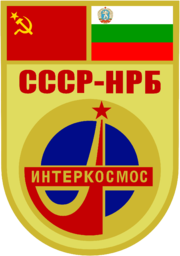Soyuz 33
| COSPAR ID | 1979-029A |
|---|---|
| Mission duration | 1 day, 23 hours, 1 minute, 6 seconds |
| Orbits completed | 31 |
| Spacecraft properties | |
| Spacecraft type | Soyuz 7K-T |
| Manufacturer | NPO Energia |
| Crew | |
| Crew size | 2 |
| Members |
Nikolai Rukavishnikov Georgi Ivanov |
| Callsign | Сатурн (Saturn) - "Saturn" |
| Start of mission | |
| Launch date | April 10, 1979, 17:34:34 UTC |
| Rocket | Soyuz-U |
| Launch site | Baikonur 1/5 |
| End of mission | |
| Landing date | April 12, 1979, 16:35:40 UTC |
| Landing site | 320 kilometres (200 mi) SE of Dzhezkazgan |
| Orbital parameters | |
| Reference system | Geocentric |
| Regime | Low Earth |
|
Soyuz programme
(Manned missions) |
|
Soyuz 33 (Russian: Союз 33, Union 33) was a 1979 Soviet manned space flight to the Salyut 6 space station. It was the ninth mission to the orbiting facility, but an engine failure forced the mission to be aborted, and the crew had to return to earth before docking with the station. It was the first-ever failure of a Soyuz engine during orbital operations.
The two-man crew, commander Nikolai Rukavishnikov and Bulgarian cosmonaut Georgi Ivanov, suffered a steep ballistic re-entry, but were safely recovered. The original intention of the mission had been to visit the orbiting crew for about a week and leave a fresh vehicle for the station crew to return to earth in. The mission failure meant that the orbiting Salyut 6 crew lacked a reliable return vehicle as their Soyuz had the same suspect engine as Soyuz 33. A subsequent manned flight was canceled and a vacant craft with a redesigned engine was sent for the crew to use.
After a two-day delay caused by a windstorm at the launch site, Soyuz 33 was launched 10 April 1979 with the fourth international crew in the Soviet Intercosmos program. Bulgarian cosmonaut Georgi Ivanov joined commander Nikolai Rukavishnikov as the craft proceeded normally towards the Salyut 6 space station.
Rukavishnikov was the first civilian to command a Soviet spacecraft, and Ivanov the first Bulgarian in space.
At 9 km distance from the station, the Igla automatic docking system was activated. But, as the craft approached to 1,000 metres, the engine failed and automatically shut down after three seconds of a planned six-second burn. Rukavishnikov had to hold the instrument panel as the craft shook so violently. After consulting with ground control, the docking system was activated again, but the engine shut down again, and Valery Ryumin, observing from the station, reported an abnormal lateral glow from behind the Soyuz during the burn. Mission control accordingly aborted the mission and told the crew to prepare to return to Earth. It was the first in-orbit failure of the Soyuz propulsion system.
...
Wikipedia

